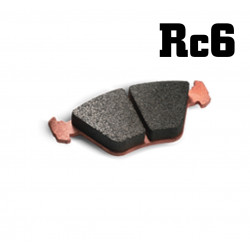PROFI CONSULTING
from 9am to 5pm
No products
*62 011
New product
4056RC6

Brake pads CL Brakes 4056RC6
CL Brake pads set for PORSCHE SIMCA ALFA ROMEO BMW MERCEDES SAABPošlite obsluhe obchodu otázku k tomuto produktu.
* povinný údaj
alebo Zrušiť

Brake pads CL Brakes 4056RC6
To be informed about product update via email, fill out the form.
* Required
or Cancel
RC6 - Snow, wet, gravel races or rear axle
Average friction coefficient µ= 0,4.
CL brakes original compound, RC6 was designed to apply to a wide range of motorsports, from rally to circuit. It has a high and very flat friction level and can be used successfully in almost every type of race car. Low compressibility provides a stiff pedal which greatly increases feedback and allows for easier modulation. It can also be used in the front or rear axle combined with the RC8 or RC5 to adjust bias.
Application:
PORSCHE 914 , 2.0 72→75 (front pads)
PORSCHE 914/6, 2.0 69→73 (front pads)
SIMCA 1000 , Rallye 1 69→81 (front pads)
ALFA ROMEO 75 , 1.8 Turbo 85→92 (rear pads)
ALFA ROMEO 75 , 2.0 Twin Spark, Veloce 85→93 (rear pads)
ALFA ROMEO 75 , 2.5 89→92 (rear pads)
ALFA ROMEO 75 , 3.0 89→92 (rear pads)
ALFA ROMEO 1750, GT 1.7 68→72 (rear pads)
ALFA ROMEO 2000 , 2.0 71→84 (rear pads)
ALFA ROMEO Alfetta , GTV6 2.5 84→87 (rear pads)
ALFA ROMEO Giulia , 66→86 (rear pads)
ALFA ROMEO Guilia , 1.6 GT Sprint (91CV) 62→62 (rear pads)
ALFA ROMEO Guilia , 1.6 T.I. Super (112CV) 63→63 (rear pads)
ALFA ROMEO Giulietta , 1.3 83→86 (rear pads)
ALFA ROMEO Giulietta , 1.6 83→86 (rear pads)
ALFA ROMEO Giulietta , 1.8 83→86 (rear pads)
ALFA ROMEO Giulietta , 2.0 83→86 (rear pads)
ALFA ROMEO Montreal, 1.8 66→77 (rear pads)
ALFA ROMEO Montreal, 2.0 66→77 (rear pads)
ALFA ROMEO Montreal, 2.6 16V 66→77 (rear pads)
ALFA ROMEO RZ , Zagato 3.0 V6 90→92 (rear pads)
ALFA ROMEO Spider , 2000 (105) 71→83 (rear pads)
ALFA ROMEO Spider , 2000 (115) 86→93 (rear pads)
ALFA ROMEO Spider, 2000 (115) Veloce 70→82 (rear pads)
ALFA ROMEO SZ , Zagato 3.0 V6 88→97 (rear pads)
BMW E12 , 530 76→81 (rear pads)
MERCEDES 190 , E 1.8 82→94 (rear pads)
MERCEDES 190 , E 2.3 (Not 16V) 82→94 (rear pads)
PORSCHE 356 , 1.6 63→66 (rear pads)
PORSCHE 356 , 1.6 C 63→66 (rear pads)
PORSCHE 356 , 63→66 (rear pads)
PORSCHE 356 , 63→66 (rear pads)
PORSCHE 356 , SC 63→66 (rear pads)
PORSCHE 911 (911) , 2.0 65→69 (rear pads)
PORSCHE 912 , 1.6 65→70 (rear pads)
SAAB 99 , 2.0 69→74 (rear pads)
SAAB 99 , 2.0 (108CV) 82→84 (rear pads)
SAAB 99 , 2.0 Turbo (146CV) 67→85 (rear pads)
SAAB 99 , 2.0i (107CV) 82→84 (rear pads)
SAAB 900 (1), 2.0 (100CV) 87→87 (rear pads)
SAAB 900 (1), 2.0 (110CV) 87→87 (rear pads)
SAAB 900 (1), 2.0 T Turbo (145CV) 80→82 (rear pads)
SAAB 900 (1), 2.0 T Turbo S (145CV) 80→82 (rear pads)
SAAB 900 (1), 2.0 T Turbo (155CV) 87→87 (rear pads)
SAAB 900 (1), 2.0 T Turbo 16S (175CV) 89→ (rear pads)
CL Brakes (previously Carbone Lorraine) created in 1919, roup is the main actor in integrated on-board railway systems with more than 4500 employees and more than 30 sites over the world. Now called "Faiveley Transport Gennevilliers" and owner of the brand CL BRAKES, the Brake Pads Department retains the manufacturing activity for its sintered metal brake pads in its historical site of Gennevilliers, France, benefiting from a common know-how in R&D acquired in aeronautic as well as in rail activities, and thus allowing a constant improvement of our materials for cars, motorcycles and mountain bikes. Sintered metal brake pads are made based on powders. The friction product contains at least ten ingredients (Bronze, ceramics, graphites...). Each of these ingredients makes the friction mixture, which is then compressed in a device that will give it its final shape. The obtained item is then positionned on its metal support and then heated in a 900+°C oven. It's the sintering process : a constituent of the product melts, consolidates the material and makes it fuse with its support. The brake pad is then rectified, checked and packed.
This discussion is especially meant for information exchange between customers. For questions regarding your order or stock availability, please contact us directly.

CL Brake pads set for PORSCHE SIMCA...
